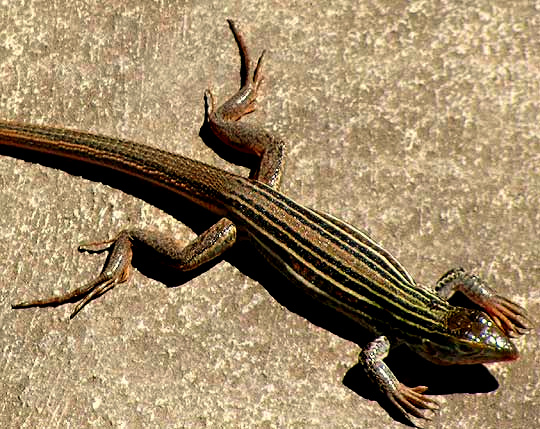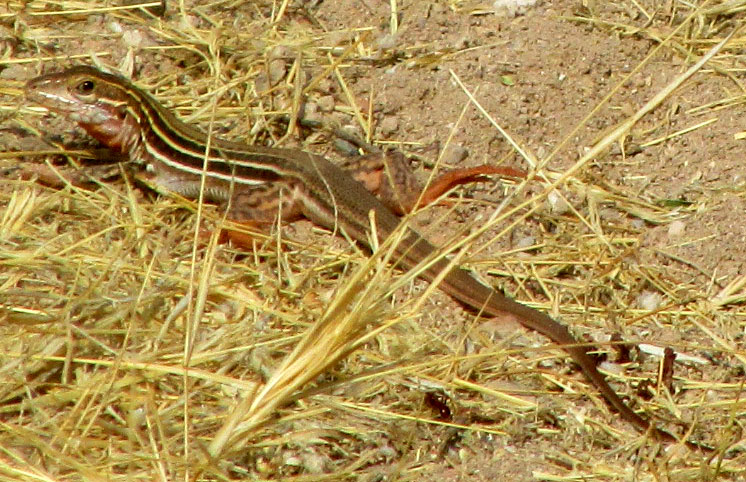Excerpts from Jim Conrad's
Naturalist Newsletter

from the September 16, 2012 Newsletter issued from the valley of the Dry Frio River in northern Uvalde County, southwestern Texas, on the southern border of the Edwards Plateau; elevation ~1750m (~5750 ft); N29.62°, W99.86°; USA
TEXAS SPOTTED WHIPTAIL
Coastal Plain Toads aren't the only critters who like the cement floor of the community's park shelter. In early mornings you're likely to see slender, eight-inch-long (20cm) lizards starkly patterned with narrow, alternating pale and dark lines quietly resting on the cement floor, basking in the warm sunlight. You can see one doing just that above. A closer look at the front end is afforded below.

On the farm in western Kentucky I grew up with a very similar lizard, the Six-lined Racerunner, Cnemidophorus sexlineatus, common in the US Southeast and south-central states. However, this is a different species, the most conspicuous difference being that the Six-lined Racerunner's black lines are solid black, while you can barely see that on our cement floor one the black lines are broken with indistinct pale spots. Also, Six-lined Racerunners tend to have brownish tails while the tail of ours is pinkish.
Our cement-floor lizard is the Texas Spotted Whiptail, ASPIDOSCELIS GULARIS, endemic to Texas and small parts of adjacent Oklahoma, New Mexico and Mexico. Being in the same genus as the Southeast's Six-lined Racerunner, you can see that the two species are closely related.
As you might guess, our whiptail eats grasshoppers, spiders, termites and the like. He's a very fast mover who when disturbed runs a short distance, stops and checks to see if he's being chased, then either nonchalantly begins walking around or continues running. He's active during the day. As with all members of the Whiptail and Racerunner Family, the Teiidae, prey is located by sight, smell and sometimes by taste, the latter by means of a long, protrusible, deeply-forked tongue. All "teiids," as the pros call members of the family, are egg-layers.
issued May 19, 2021 from the February 27, 2011 Newsletter issued from from the valley of the Dry Frio River in northern Uvalde County, southwestern Texas, on the southern border of the Edwards Plateau; elevation ~1750m (~5750 ft); N29.62°, W99.86°; USA
TEXAS SPOTTED WHIPTAIL NEST
The soil where a garden is planned is too rocky, compacted and void of organic matter to successfully grow garden plants, so about four months ago Fred the property owner ordered a truckload of topsoil being scraped from a building site in Uvalde. It was dumped in a pile beside the future garden. The last few weeks, for my two hours of labor each morning, I've been wheelbarreling that topsoil into the garden enclosure. Today as I was digging into the heap of topsoil I exposed what's shown below:

A clutch of eight eggs were exposed about 2½ inches (6.4cm) below the heap's surface. The soil at that depth, loose and crumbly when first dumped there, now after some rains was just loose enough that I could fairly easily break away chunks of it with a finger. I'm identifying the nest as probably belonging to a Texas Spotted Whiptail because in recent days as I was digging into the heap three times I saw individuals of that species shoot from holes in the dirt.
Also, in 1987 Stanley Trauth published an article in The Southwestern Naturalist entitled "Natural Nests and Egg Clutches of the Texas Spotted Whiptail, Cnemidophorus gularis gularis (Sauria: Teiidae), from Northcentral Texas," freely downloadable at the JSTOR.Org website. Trauth describes burrows of the species as being as deep as about 30cm, or only half as deep as the one pictured. However, his nests were in more compacted eroded soil and gravel of roadside embankments, while our soil was more granular, without rocks, and the surface sloped at about a 45 degree angle. Trauth's pictures of a whiptail clutch show white eggs shaped like the ones in the picture. He unearthed three clutches, with 6, 6, and 7 eggs, as opposed to our eight eggs. All this doesn't amount to a positive identification of the nest, but it's positive enough for me to park the picture and information here for future folks looking for insights into the Texas Spotted Whiptail.
entry dated May 24, 2022, issued from near Tequisquiapan, elevation about 1,900m (6200 ft), Querétaro state, MÉXICO
SPOTTED WHIPTAIL IN CENTRAL MEXICO

During the driest, dustiest days of the late dry season -- it should have rained by now -- the above lizard was spooked from grass along a trail amid abandoned and dry-season-fallow corn and alfalfa fields. However, before disappearing into a big clump of grass, it paused long enough for the above photo. It looked a lot like the whiptails seen so often during our stay in southwestern Texas, and after considerable study of the matter, I think it probably was. In the US they call this species the Texas Spotted Whiptail, but down here that name doesn't work. Whatever the English, it's Aspidoscelis gularis.
Doubt about which whiptail species we have here arose because it looks so similar to another whiptail species that might be in the area, Aspidoscelis communis, in English often called the Colima Giant Whiptail. Also, it's unsettling that our individual doesn't display as many spots as most pictures of the Spotted Whiptail, Aspidoscelis gularis, on the Internet.
However, The Reptile Database reports a study indicating that Aspidoscelis communis doesn't occur here in Querétaro state, while the 2014 publication by Carlos Pérez-Almazán and others, entitled "Distribución Potencial del Complejo Aspidoscelis gularis (Squamata: Teiidae) en México" indicates that in Querétaro the species has been collected numerous times, and our environment -- hot, dry and grassy -- is just what Spotted Whiptails like.
Also, Pérez-Almazán makes clear that there's tremendous variation within the species, in which six subspecies are noted.
In fact, our Texas Spotted Whiptails hadn't been very spotted, either.
entry dated July 13, 2022, issued from near Tequisquiapan; elevation about 1,900m, (6200 ft), ~N20.57°, ~W99.89°; Querétaro state, MÉXICO
A SPOTTED SPOTTED WHIPTAIL IN MEXICO

In mid July the rainy season expected at the end of April still hasn't arrived and the grossly overgrazed, eroded, grass-stubble ranchlands are very crispy dry. Along a trail through this is where the above Spotted Whiptail appeared, this time with spots. An image of an individual spotted and colored just like ours stands atop the title page at the above-mentioned publication Distribución Potencial del Complejo Aspidoscelis gularis (Squamata: Teiidae) en México.
Meanwhile another article has turned up, a 2016 work by Francisco Ayala-Flores and Uriel Hernández-Salinas entitled "Descripción de los hábitos alimentarios de Aspidoscelis gularis (Sauria: Teiidae), durante la temporada de lluvias en el sureste to Querétaro, México." It's about this species' feeding habits during the rainy season (supposedly now) in southeastern Querétaro, which is where we are.
These authors found that the items most consumed by both sexes were termites, and less frequently adult beetles and cockroaches.
Also they describe the species as occurring about as far south in Mexico as here in Querétaro state.